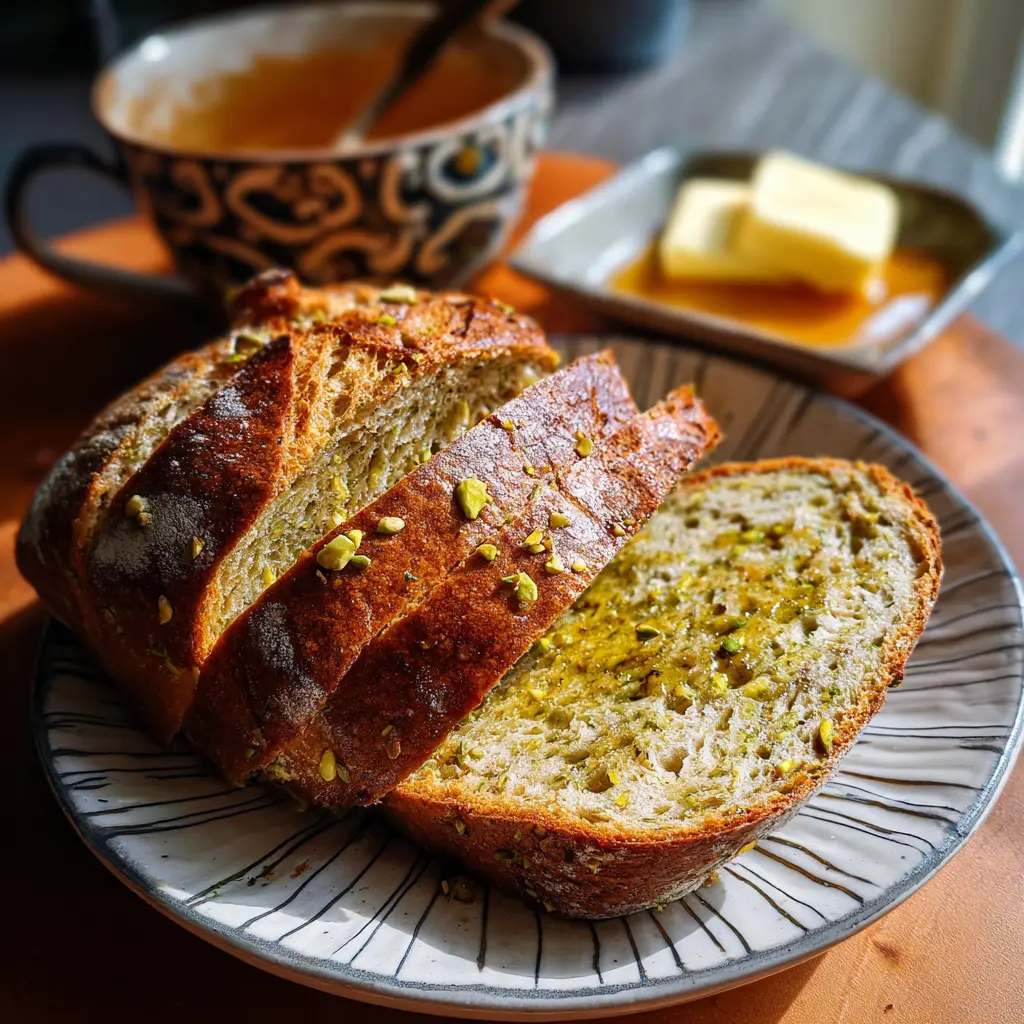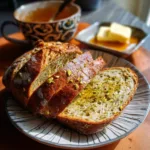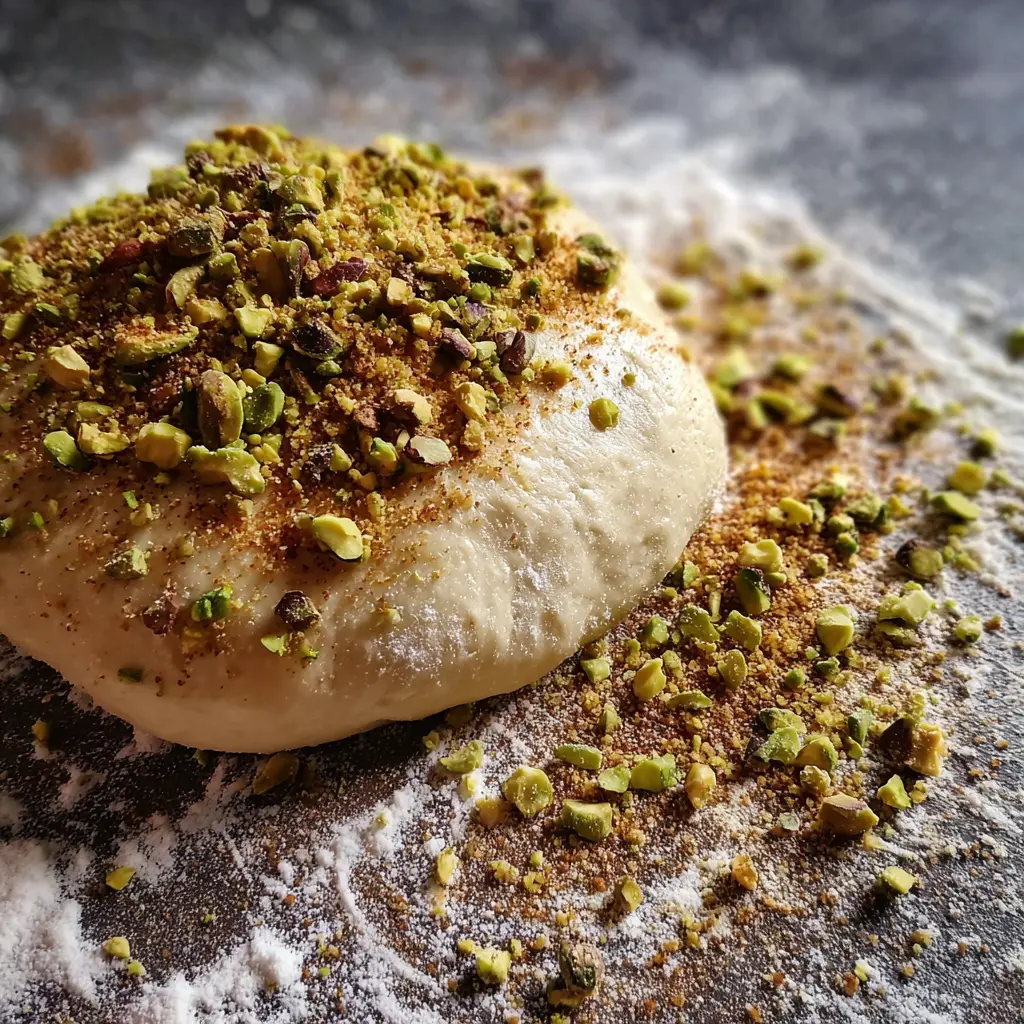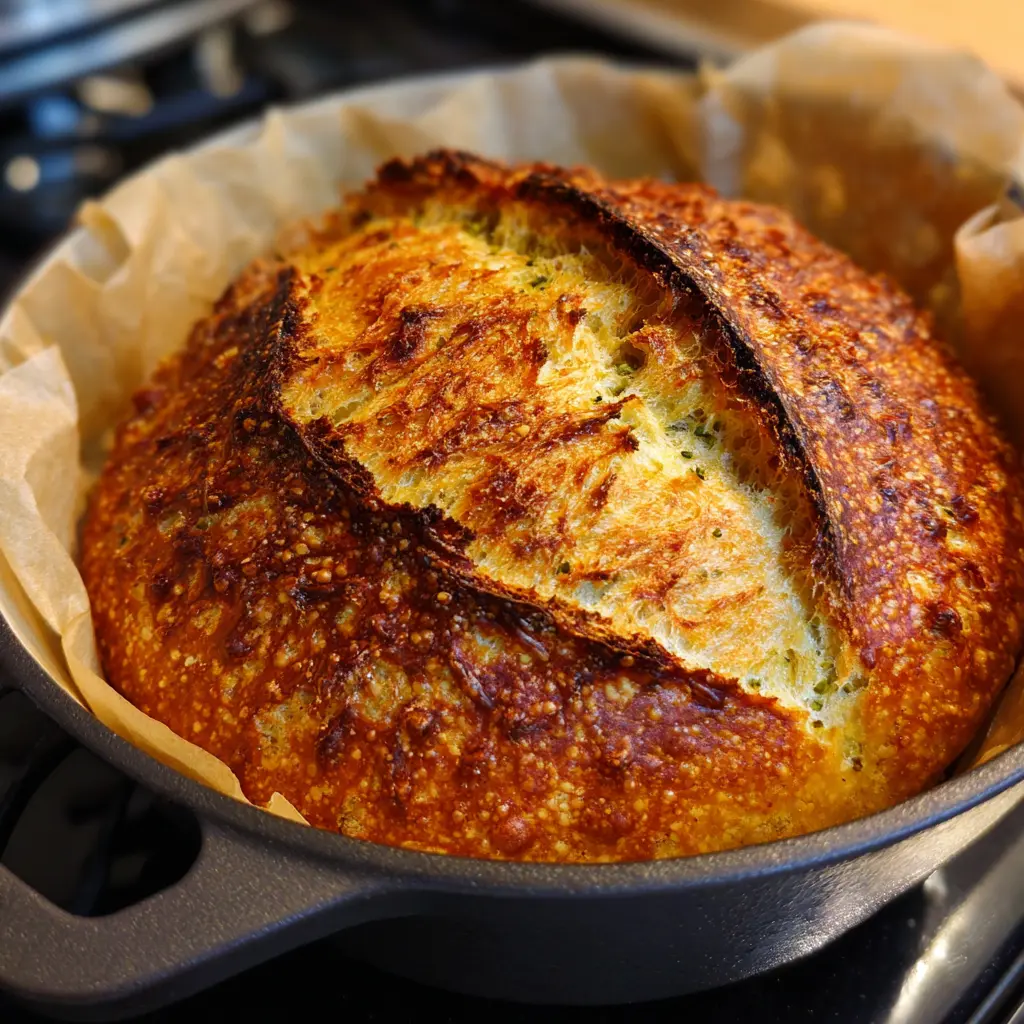Introduction to Sourdough Pistachio Bread
Sourdough pistachio bread is more than a recipe—it’s a reflection of how DishRCP brings comfort, creativity, and craft together in every bake. At DishRCP, we believe great food tells a story, and this loaf captures one of our favorites: a balance of tangy sourdough, crunchy pistachios, and warm, sweet spices that feels both comforting and new.
This bread came to life on a slow weekend afternoon in our test kitchen. We had a starter that was ripe and bubbly, a stash of roasted pistachios waiting to be used, and the idea of layering flavor rather than just mixing it. So we folded, we shaped, we sprinkled—and out came a bread that tasted like something special. Sweet from a touch of honey, warm with cinnamon, and packed with texture from crushed pistachios inside and out.
What makes this bread stand out is how the flavors develop at each stage: from the fermented dough’s depth to the nutty crunch in every bite. It’s not a dessert loaf. It’s not a savory bread. It’s somewhere deliciously in between.

Table of Contents
Table of Contents

Sourdough Pistachio Bread
- Total Time: 4 hours 45 minutes
- Yield: 1 large loaf (8–10 slices)
Description
A rustic artisan sourdough loaf, naturally leavened with your starter, packed with golden honey, crunchy pistachios, and swirls of brown sugar and cinnamon—baked to perfection right at home.
Ingredients
Bread Dough
- 100 g Sourdough Starter (active and bubbly)
- 350 g Water
- 40 g Honey
- 500 g Bread Flour
- 10 g Salt
Added During Stretch and Folds
- 50 g Pistachios (chopped)
Added During Shaping
- 30 g Pistachios (chopped)
- 20 g Brown Sugar
- 10 g All Purpose Flour
- ½ tablespoon Cinnamon
Instructions
Pre-Mix & Autolyse
In a glass or ceramic bowl, combine your sourdough starter, water, and honey. Stir well until the starter and honey are mostly dissolved into the water.
Next, add the flour and salt. Mix everything with a spatula until a rough, shaggy dough forms. It’ll feel dry and just barely come together.
Cover the bowl with plastic wrap or a damp towel and let it rest for about 1 hour.
Forming the Dough
After resting, begin shaping the dough into a ball. Work around the bowl by pulling the dough from the edges and folding it over the center. Repeat 20–25 times until the dough looks smoother and tighter.
Cover again and let it rest for 30 minutes.
Stretch & Fold – Build the Structure
It’s time to start strengthening your dough. This is also when you’ll add the pistachios.
Perform your first set of stretch and folds without any mix-ins. Then, on the second or third set, gently incorporate 50g of chopped pistachios into the dough.
Do a total of 4 sets of stretch and folds, with about 15–30 minutes of rest between each round.
Bulk Fermentation
After the final stretch and fold, cover the dough again and let it bulk ferment at room temperature. Because of the honey and nuts, fermentation may move quickly—keep an eye on the dough’s rise.
While it ferments, mix together the remaining chopped pistachios, brown sugar, cinnamon, and all-purpose flour in a small bowl. Set it aside for shaping.
Shaping
Once the dough has finished its bulk rise, it’s time to shape.
Lightly stretch the dough into a rectangle. Sprinkle on some of your pistachio sugar mixture. Fold the top down, sprinkle again. Fold in the sides, sprinkle again. Use as much of the mixture as you like.
Roll the dough up like a burrito, then gently pull it toward you to build surface tension.
Transfer the shaped dough seam-side up into a floured banneton. Stitch the seam if necessary.
Cold Fermentation
Cover the banneton loosely with a damp towel or place it in a plastic bag. Refrigerate the dough for a cold ferment—ideally at least 5 hours, or overnight.
Getting Ready to Bake
When you’re ready to bake, preheat your oven to 230°C (450°F) with your Dutch oven inside. Let it preheat for about 1 hour so everything is fully heated.
Baking
Remove the dough from the fridge and carefully turn it out onto a piece of parchment paper.
Score the top with a sharp blade or lame.
Carefully lower the dough (with parchment) into the hot Dutch oven. Cover with the lid and bake:
30 minutes with the lid on at 230°C (450°F)
10–15 minutes with the lid off at 210°C (410°F)
Tip: Place a baking sheet on the rack below your Dutch oven if you’re worried about the bottom burning.
Cooling
Once baked, remove the bread from the Dutch oven and transfer to a wire rack. Let it cool completely before slicing to enjoy that perfect sourdough texture.
Notes
Sourdough Starter Tips
This recipe assumes you’re working with a lively, active starter that’s been fed a few hours before you begin baking. Not sure if your starter is ready? Check this guide. I typically use 100g of starter, but in warmer environments, you might want to reduce that amount—see this resource for help adjusting quantities.
Stretch & Fold Guidance
You’ll be incorporating a good amount of mix-ins during the stretch and fold stage. Don’t stress if the dough tears a bit—it’s normal. Let it rest, and it will come back together as it absorbs all the inclusions.
Spice Mix & Flour Note
I added a bit of all-purpose flour to the spice mixture to help prevent the brown sugar from seeping out during the cold ferment stage. It makes a big difference.
Baking Advice
Worried about a burnt bottom? Slide a baking sheet onto the rack beneath your Dutch oven—problem solved.
Concerned it might not bake through? Once the bake time is up, turn the oven off, place the loaf directly on the oven rack, leave the door slightly open, and let it sit for a few hours to finish internally.
Most importantly, resist the urge to slice it too soon! Let your bread cool for at least 4–6 hours for the best texture.
- Prep Time: 4hours
- Cook Time: 45minutes
- Category: Baking, Side Dish, Sides
- Cuisine: American
Nutrition
- Serving Size: 100g
- Calories: 3136kcal
- Sodium: 3951mg
- Fat: 49g
- Saturated Fat: 5g
- Unsaturated Fat: 22g
- Trans Fat: 16g
- Carbohydrates: 605g
- Fiber: 34g
- Protein: 79g
Ingredients & Nutritional Benefits of Sourdough Pistachio Bread
Complete Ingredient List with Pro Tips
To make sourdough pistachio bread truly memorable, every ingredient plays a part in texture, flavor, and structure. Here’s what you’ll need—and why each one matters:
Bread Dough Ingredients:
- 100g Sourdough Starter – Must be active, bubbly, and fed within the last 4–6 hours. This is the heart of fermentation.
- 350g Water – Hydration is crucial. Filtered or spring water is best for a stronger rise.
- 40g Honey – Brings gentle sweetness and helps keep the crumb soft and tender.
- 500g Bread Flour – High-protein flour strengthens the gluten network.
- 10g Salt – Boosts overall flavor and helps regulate yeast fermentation.
Add-ins During Stretch & Fold:
- 50g Chopped Pistachios – These get folded into the dough for texture and bite in every slice.
Add-ins During Shaping:
- 30g Chopped Pistachios – Extra crunch and visual appeal.
- 20g Brown Sugar – Caramelizes during baking for subtle sweetness.
- 10g All-Purpose Flour – Helps prevent sugar leakage during proofing.
- ½ Tbsp Ground Cinnamon – Warms the overall flavor and pairs beautifully with pistachios.
Pro Tip: Use unsalted, roasted pistachios for deeper flavor. Lightly toasting them before chopping enhances their nutty profile.
For more recipes follow my pinterest
Understanding the Role of Each Ingredient
Every component in this recipe brings something unique:
| Ingredient | Purpose |
|---|---|
| Sourdough Starter | Leavening, fermentation flavor |
| Honey | Softness, natural sweetness |
| Bread Flour | Gluten development for structure |
| Salt | Flavor balance, fermentation control |
| Water | Activates flour, regulates hydration |
| Pistachios | Texture, color, nutty flavor |
| Cinnamon | Aroma, flavor layering |
| Brown Sugar | Adds caramel tones, creates crust contrast |
| All-Purpose Flour | Helps absorb sugar and moisture during cold proof |
When layered properly during shaping, the brown sugar and cinnamon swirl in subtle patterns throughout the loaf, making every bite just a little different—and a lot more enjoyable.
Nutritional Benefits of Pistachios and Sourdough
You might think bread is just carbs, but this loaf brings real nutritional value to the table. Thanks to pistachios and the fermentation process, this is a smarter indulgence.
Top Nutritional Highlights:
- Protein Boost – Pistachios add plant-based protein
- Fiber-Rich – Natural fiber from both the flour and nuts aids digestion
- Lower Glycemic Impact – Thanks to sourdough’s fermentation, the bread digests slower
- Good Fats – Pistachios provide heart-healthy mono- and polyunsaturated fats
- Fermented Benefits – Sourdough fermentation can improve gut health and nutrient absorption
Here’s a nutritional breakdown per loaf (based on 100g servings):
| Nutrient | Amount |
|---|---|
| Calories | 3136 kcal |
| Carbs | 605g |
| Protein | 79g |
| Fat | 49g |
| Fiber | 34g |
| Sugar | 86g |
| Sodium | 3951mg |
| Potassium | 1929mg |
| Calcium | 245mg |
| Iron | 12mg |
| Vitamin A | 99 IU |
| Vitamin C | 11mg |
It’s comforting, energizing, and nutrient-dense—a win for flavor and fuel.
Caloric and Macronutrient Breakdown Table
Want a quick overview of the macronutrient composition?
| Macronutrient | Total per Loaf | Per 100g Serving |
|---|---|---|
| Carbohydrates | 605g | 60.5g |
| Protein | 79g | 7.9g |
| Fat | 49g | 4.9g |
| Sugars | 86g | 8.6g |
This bread is rich enough to satisfy yet balanced enough to enjoy without guilt.

Preparing the Dough – Autolyse & Pre-Mix Process
Get Your Sourdough Starter Ready First
Before you begin making sourdough pistachio bread, make sure your sourdough starter is bubbly, active, and at peak fermentation. Feed it 4–6 hours ahead of mixing, using equal weights of flour and water. A good sign it’s ready? It should float when dropped in water—light and airy, just what this recipe needs.
Why does this matter? A strong starter ensures a better rise, deeper flavor, and a more predictable fermentation timeline—especially in enriched breads like sourdough pistachio bread, where ingredients like honey and nuts are involved.
Start With the Wet Ingredients
In a large mixing bowl, combine:
- 100g sourdough starter
- 350g filtered water
- 40g honey
Whisk or stir everything together until the starter dissolves and the liquid looks cloudy. This mixture becomes the base for your sourdough pistachio bread, supplying natural sugars to feed the fermentation process and enhancing the loaf’s gentle sweetness.
Add the Dry Ingredients to Form the Dough
Now stir in:
- 500g bread flour – rich in protein for better structure
- 10g sea salt – regulates fermentation and brings flavor into balance
Mix by hand or with a spatula until a rough dough comes together. The texture at this point will be scrappy and uneven—that’s perfectly fine.
Cover the bowl with a damp towel and let the dough sit for an autolyse period of 60 minutes.
What Is Autolyse and Why You Shouldn’t Skip It
The autolyse stage is a quiet but powerful phase in any artisan bread. It allows flour to fully hydrate and the gluten network to begin forming naturally. In sourdough pistachio bread, which includes hearty mix-ins like nuts and sugar, a solid gluten foundation is critical for holding shape.
During autolyse:
- Flour absorbs the water fully
- Enzymes start unlocking sugars for the sourdough bacteria
- The dough becomes softer, smoother, and easier to fold later
After about an hour, you’ll notice the dough feels more elastic. That means it’s ready for the stretch-and-fold technique—the next key step in building structure for your sourdough pistachio bread masterpiece.
Stretch and Folds – Building the Dough Structure
Why Sourdough Pistachio Bread Needs the Stretch and Fold Method
One of the most crucial techniques for a well-developed loaf is the stretch and fold method—especially when making sourdough pistachio bread. This process helps build strength and structure without the need for hard kneading. By using gentle folds, the dough maintains its lightness while forming the gluten that’s essential for rise and texture.
Because sourdough pistachio bread includes mix-ins like nuts and sugar, stretching instead of kneading protects the dough’s integrity. It keeps the pistachios suspended throughout instead of sinking or clumping.
How to Stretch and Fold Like a Pro
After your dough has rested during autolyse, you’re ready to begin your first fold:
- Wet your hands to reduce sticking.
- Lift one edge of the dough and gently stretch it upward.
- Fold it over to the opposite side.
- Turn the bowl slightly and repeat this motion on all four sides.
- Cover the bowl and let it rest for 25 minutes.
Repeat this four times, spacing each fold with a rest period. You’ll see the dough getting stronger and more elastic. This strength is exactly what you want in sourdough pistachio bread.
When to Add the Pistachios for Best Results
To get that signature crunch in every bite, add 50g of chopped pistachios after your first fold—typically during the second set.
Here’s what to do:
- Sprinkle pistachios across the dough’s surface before starting the fold
- Continue with the stretch and fold motion
- Avoid overhandling to keep the dough light and airy
This step helps incorporate the nuts evenly, so your sourdough pistachio bread bakes with consistent texture throughout.
How You’ll Know the Dough Is Ready
After the final fold, your dough should feel smoother, stronger, and more elastic. It should lift easily without tearing and spring back slightly when touched. That bounce means the gluten structure is holding.
For sourdough pistachio bread, these signs indicate the dough is ready to move on to the fermentation stage—where the flavors really come alive.
Bulk Fermentation & Flavor Development
What Happens During Bulk Fermentation?
Bulk fermentation is where the magic happens. During this resting period, wild yeast and bacteria from your starter go to work, creating gas bubbles and flavor compounds. This fermentation stage not only helps the dough rise but also brings depth to your sourdough pistachio bread.
The longer the dough rests, the more complex the taste becomes. Natural acids develop, contributing to that slightly tangy flavor sourdough is known for. For enriched loaves like sourdough pistachio bread, this stage must be carefully timed to avoid overproofing, especially since we’re working with added sugars and fats.
How to Know When Bulk Fermentation Is Complete
This step typically lasts 4 to 6 hours, depending on room temperature. Honey in the dough speeds things up, so don’t just rely on time—look for visual signs.
Here’s how you know your sourdough pistachio bread dough is ready:
- It has nearly doubled in size
- You see small bubbles just under the surface
- The dough jiggles slightly when the bowl is moved
- It feels puffed and airy when gently pressed
If the dough deflates easily or has a strong alcohol smell, it may be over-fermented. Keep an eye on it!
Prepare the Brown Sugar Pistachio Mix
As the dough ferments, get your delicious swirl mixture ready. This step adds a sweet, nutty layer that makes sourdough pistachio bread truly unique.
In a small bowl, combine:
- 30g chopped pistachios
- 20g brown sugar
- 10g all-purpose flour
- ½ tablespoon cinnamon
The all-purpose flour helps absorb moisture and prevents the sugar from leaking during proofing. Stir the ingredients together and set the mix aside. This will be used during shaping to layer inside your dough.
Why This Mixture Enhances Flavor
Unlike mix-ins that get lost in the dough, this layer is rolled in during shaping. As it bakes, the brown sugar caramelizes and the cinnamon melds with the pistachios, forming a rich swirl of warmth and sweet, nutty flavor.
This approach makes your sourdough pistachio bread stand out. Each slice reveals a marbled center that’s as gorgeous as it is tasty.
Shaping Your Sourdough Pistachio Bread
Turning Fermented Dough into a Structured Loaf
After bulk fermentation, your dough is soft, bubbly, and full of potential. This is where shaping comes in. For sourdough pistachio bread, shaping serves two key purposes: it creates tension for better oven spring and locks in the sweet pistachio swirl that makes this bread so special.
Whether you’re going for a batard or boule, the method remains simple and focused—shape with care, not force.
Rolling in the Cinnamon-Pistachio Filling
The standout feature of sourdough pistachio bread is its layered, nutty filling. To incorporate this without disrupting the dough’s structure, follow these steps:
- Dust your counter with a little flour.
- Flatten the dough gently into a rough rectangle (around 10″ x 12″).
- Sprinkle the pistachio-brown sugar-cinnamon mixture across the surface.
- Fold the dough like you’re closing a letter—bring the top third down, then the bottom third up over it.
- Then fold the sides inward to trap the mixture.
- Roll the dough up tightly, like a log, seam down.
This spiral traps the sweet mix inside, delivering flavor in every slice.
Surface Tension: The Secret to a Tall, Round Bake
Once shaped, the dough needs to hold its form. That’s where surface tension matters.
To build tension:
- Gently pull the loaf toward you on the counter using your palms.
- Turn the dough and repeat the fold until the surface feels tight and smooth.
Don’t overwork it. The goal is to secure the loaf without flattening all the air you’ve built during fermentation.
Into the Banneton for Cold Proofing
Transfer the dough, seam-side up, into a floured banneton or proofing bowl. If your seam looks loose, give it a pinch to hold everything together during the final rise.
Cover with a damp towel or place the banneton inside a clean plastic bag. Then refrigerate it for a cold proof of at least 5 hours. Longer rests, up to 12 hours, will develop a richer flavor and make the dough easier to score before baking.
This slow proof helps your sourdough pistachio bread finish developing its full character—flavor, structure, and aroma.
Cold Fermentation & Final Proofing Tips
Why Cold Fermentation Enhances Flavor and Structure
One of the most important steps in making incredible sourdough pistachio bread is cold fermentation. This slow resting period in the fridge allows the dough to develop deeper flavor, better texture, and improved handling for scoring and baking.
During cold proofing, yeast activity slows while enzymes continue to break down the dough. This results in a more complex, slightly tangy taste that balances beautifully with the sweet swirl of pistachios and brown sugar.
How Long Should You Cold Ferment?
For best results, refrigerate your shaped dough for at least 5 hours, but ideally 8–12 hours. This longer fermentation not only builds flavor, it also firms up the dough—making it easier to score cleanly before baking.
Your sourdough pistachio bread will benefit from this extended rest, producing a loaf with a crackly crust and evenly baked interior.
Tips for Proofing Success
Here are a few practical tips to get your final proof just right:
- Cover the dough tightly: Use a plastic bag or wrap to avoid drying out the surface.
- Chill at consistent temperature: Keep your fridge between 37°F–40°F for stable results.
- Don’t overproof: While longer cold fermentation is great, going beyond 16 hours may weaken the dough’s structure.
When fully proofed, the dough should hold its shape, feel slightly firm to the touch, and spring back slowly when pressed.
Prepping for Baking Day
Once cold proofing is done, it’s almost time to bake your sourdough pistachio bread—but there are a few steps to handle first.
Here’s what to do right before baking:
- Preheat your oven to 450°F (230°C) at least an hour before baking.
- Place your Dutch oven inside during preheat to get it hot.
- Carefully take the dough out of the fridge and place it onto a sheet of parchment paper.
- Dust with flour if needed for easier scoring.
This prep ensures your loaf will get a powerful oven spring and bake evenly from crust to crumb.
Baking to Golden Perfection
Preheat Like a Pro
A hot oven is the key to excellent sourdough pistachio bread. The temperature and environment in the first few minutes of baking determine how well your loaf will rise, crust, and color.
Start by preheating your oven to 450°F (230°C). Place your Dutch oven inside during preheat. It needs at least 45 minutes to fully heat—1 hour is ideal. A blazing-hot Dutch oven ensures your bread gets the maximum oven spring right from the start.
Scoring: Creating Room for Expansion
Before you bake, the dough needs to be scored. This helps control how your sourdough pistachio bread opens up in the oven.
Follow these simple steps:
- Gently flip the cold dough from the banneton onto parchment paper.
- Dust lightly with flour for visibility.
- Use a sharp razor, bread lame, or knife to make a controlled slash across the surface. A single ½-inch deep cut at a slight angle works well.
- For extra style, you can add a few shallow decorative slashes.
This technique not only looks great but helps steam escape and the loaf rise without bursting unpredictably.
Bake with Confidence
Once scored, use the parchment paper to lower your loaf into the hot Dutch oven. Put the lid on and slide it into the oven.
Bake in two stages:
- Bake for 30 minutes covered – The trapped steam helps the bread rise and develop a glossy, crisp crust.
- 10–15 minutes with the lid off at 410°F (210°C) – This step browns the crust and finishes the bake.
Tip: Worried about the bottom burning? Slide a baking sheet on the lower rack to deflect heat away from the base.
The scent of roasted pistachios, cinnamon, and caramelized sugar will start filling your kitchen. It’s a sign your sourdough pistachio bread is nearly ready!
How to Check for Doneness
Knowing when your bread is done is just as important as getting it into the oven.
Look for:
- A golden-brown crust, deep and even in color
- A hollow sound when tapped on the bottom
- An internal temperature around 205°F (96°C)
If you’re unsure, turn off the oven and leave the loaf inside with the door cracked for 10 minutes. This ensures a fully set center without overbaking.
Cooling, Slicing, and Serving
Resting Your Loaf the Right Way : sourdough pistachio bread
After baking, your sourdough pistachio bread needs time to cool properly. Although it may look ready to eat, slicing too early can lead to a gummy or undercooked center. The inside continues cooking after it leaves the oven, and rushing this stage can undo all your hard work.
Let the loaf cool on a wire rack for a minimum of 2 hours. Ideally, wait 4–6 hours for a firm crumb and fully developed texture. Trust the process—your finished sourdough pistachio bread will be much easier to cut and far more satisfying.
How to Slice Without Crushing the Crumb
Use a serrated bread knife to get clean, neat slices. A light sawing motion works best—no need to press down. Start at one end and guide your knife through gently. This helps maintain the interior’s shape and protects the structure you’ve developed over hours of fermentation and folding.
Every slice of your sourdough pistachio bread should showcase the swirl of pistachios and cinnamon. Take your time and enjoy the reveal.
Creative Ways to Serve and Enjoy
There’s more than one way to enjoy this loaf. Its balance of nutty, sweet, and tangy flavors makes it incredibly versatile.
Here are some favorite ways to serve sourdough pistachio bread:
- Toasted with ricotta and a drizzle of honey
- Topped with fresh fruit for a quick breakfast
- Paired with soft cheeses and nuts on a charcuterie board
- Turned into French toast for a luxurious weekend brunch
- Served alongside coffee as a midday treat
Because of its natural richness, this bread also works well as a gift or a bring-along for gatherings.
Storing for Freshness and Flavor
If you’re not finishing the whole loaf right away, storing it properly will help maintain its flavor and texture.
Here’s how to store your sourdough pistachio bread:
- Short-term (1–2 days): Keep it at room temperature wrapped in a cotton towel or inside a paper bag.
- Long-term: Slice and freeze the loaf in a freezer-safe bag. Toast slices directly from the freezer as needed.
- Avoid plastic bags: They trap moisture and make the crust go soft.
To refresh the crust, warm the loaf in the oven at 325°F for 8–10 minutes before serving.

Conclusion: A Truly Rewarding Bake
There’s something incredibly satisfying about baking sourdough pistachio bread from scratch. It’s not just about the ingredients or the technique—it’s about creating something beautiful, nourishing, and full of flavor with your own two hands.
This recipe brings together the deep, complex flavor of sourdough with the sweet crunch of pistachios and warm notes of cinnamon. Every stage, from mixing and folding to shaping and baking, builds on the last—resulting in an artisan loaf that’s as rewarding to make as it is to share.
Whether you’re baking to unwind, to impress, or simply to fill your kitchen with something comforting and wholesome, this loaf delivers. With its golden crust, swirled interior, and rich aroma, sourdough pistachio bread stands out in both taste and presentation.
Frequently Asked Questions About Sourdough Pistachio Bread
What is the best sourdough pistachio bread recipe?
The best sourdough pistachio bread recipe includes a balanced blend of sourdough starter, honey, cinnamon, and roasted pistachios. The flavor comes from layers: pistachios are folded into the dough and rolled in with brown sugar during shaping. A slow cold proof enhances the taste and texture. The crust is crisp, and the crumb reveals beautiful sweet swirls in every slice.
Can I make cranberry pistachio sourdough bread?
Yes, you can easily turn this into cranberry pistachio sourdough bread. Just add about 50g of dried cranberries along with the pistachios during your second stretch and fold. Their tartness balances perfectly with the sweet and nutty filling. For best results, soak the cranberries in warm water for 10 minutes and pat dry before mixing in.
How do I make cranberry sourdough bread without pistachios?
To make a cranberry sourdough bread without pistachios, simply omit the nuts and add cranberries directly to the dough during bulk fermentation. Enhance the flavor with a bit of orange zest or cinnamon. The dough structure remains the same, and the fruit adds natural sweetness and chew.
Can I substitute walnuts for pistachios in sourdough bread?
Absolutely! You can swap pistachios for walnuts to create a walnut sourdough bread. Use the same amount (about 80g total) and toast them lightly for richer flavor. Walnuts pair beautifully with cinnamon, brown sugar, and even dried fruits like figs or raisins.
Is sourdough pistachio bread sweet or savory?
Sourdough pistachio bread is slightly sweet, thanks to the honey and brown sugar layers. It’s not overly sugary—more like a balanced, naturally sweet artisan loaf. The pistachios give it crunch, and the sourdough base adds a tang that balances the flavor. It’s perfect for both breakfast and snacking.
